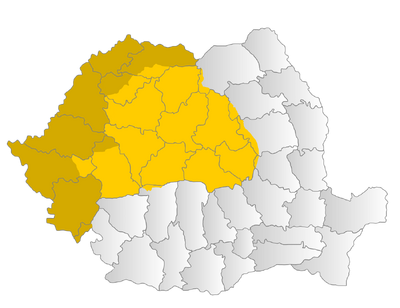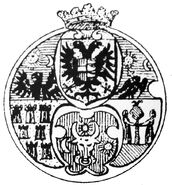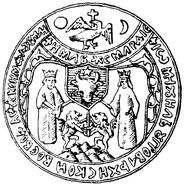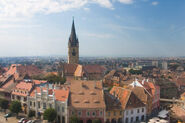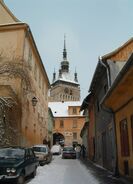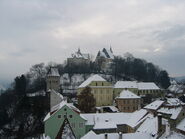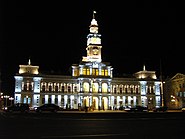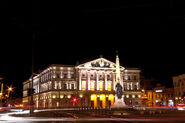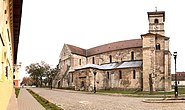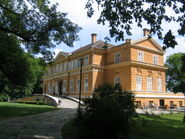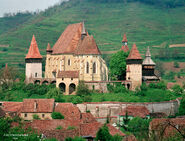| Transylvania Transilvania / Ardeal (Romanian) Erdély (Hungarian) Siebenbürgen (German) |
|||
|---|---|---|---|
| — Historical region of Romania — | |||
|
|||
Transylvania proper Banat, Crișana and Maramureș
|
|||
| Country | |||
| Area | |||
| • Total | 100,287 km2 (38,721 sq mi) | ||
| Time zone | EET (UTC+2) | ||
| • Summer (DST) | EEST (UTC+3) | ||

Geogel, Romanian Orthodox wooden church

Sirnea in Brașov County
Transylvania is a historical region in the central part of Romania. Bounded on the east and south by the Carpathian mountain range, historical Transylvania extended in the west to the Apuseni Mountains; however, the term sometimes encompasses not only Transylvania proper, but also the historical regions of Crişana, Maramureş, and Romanian part of Banat.
Transylvania is often associated with vampires[1][2][3] (chiefly due to Bram Stoker's novel Dracula and its film adaptations) and the horror genre in general, while the region is also known for the scenic beauty of its Carpathian landscape and its rich history.
Etymology[]
In Romanian, the region is known as Ardeal (pronounced [arˈde̯al]) or Transilvania (pronounced [transilˈvani.a]); in Hungarian as Erdély; in German: Siebenbürgen (help·info); and in Turkish as Transilvanya and historically as Erdel; see also other denominations.
- Transylvania was first referred to in a Medieval Latin document in 1075 as ultra silvam, meaning "beyond the forest" (ultra (+accusative) meaning "beyond" or "on the far side of" and the accusative case of sylva (sylvam) meaning "wood or forest"). Transylvania, with an alternative Latin prepositional prefix, means "on the other side of the woods". Hungarian historians claim that the Medieval Latin form Ultrasylvania, later Transylvania, was a direct translation from the Hungarian form Erdő-elve (rather than the Hungarian being derived from the Latin).[4] That also was used as an alternative name in Ukrainian Залісся (Zalissya).
- The German name Siebenbürgen means "seven fortresses", after the seven (ethnic German) Transylvanian Saxons' cities in the region. The order in which they were settled in Transylvania being as follows: Mediasch, 1142; Muhlenbach, 1150; Hermannstadt, the capital, 1160; Clausenburg,[5] 1178; Schässburg, 1178; Reussmarkt, 1198; Broos, 1200. To these seven were subsequently added two others, Bistritz, 1206; and Kronstadt, 1208.[6] This is also the origin of the region's name in many other languages, such as the Polish Siedmiogród and the Ukrainian Семигород (Semyhorod).
- The Hungarian form Erdély was first mentioned in the 12th century Gesta Hungarorum as "Erdeuleu". Erdel, the Turkish equivalent originates from this form, too.
- The first known written occurrence of the Romanian name Ardeal appeared in a document in 1432 as Ardeliu.[7]
History[]

Fortified church of Biertan, a UNESCO World Heritage Site.
Brief survey[]
Transylvania has been dominated by several different peoples and countries throughout its history. It was once the nucleus of the Kingdom of Dacia (82 BC–106 AD). In 106 AD the Roman Empire conquered the territory, systematically exploiting its resources. After the Roman legions withdrew in 271 AD, it was overrun by a succession of various tribes, bringing it under the control of the Carpi (Dacian tribe), Visigoths, Huns, Gepids, Avars, Slavs and Bulgarians. It is a subject of dispute whether elements of the mixed Daco–Roman population survived in Transylvania through the Dark Ages (becoming the ancestors of modern Romanians) or the first Vlachs appeared in the area in the 13th century after a northward migration from the Balkan Peninsula.[8][9] There is an ongoing scholarly debate over the ethnicity of Transylvania's population before the Hungarian conquest (see Origin of the Romanians).
The Magyars conquered much of Central Europe at the end of the 9th century. According to Gesta Hungarorum, Transylvania was ruled by Vlach voivode Gelou after the Hungarians arrived. The Kingdom of Hungary firmly established control over Transylvania in 1003, when king Stephen I, according to legend, defeated the prince named Gyula.[10][11][12][13] Between 1003 and 1526, Transylvania was a voivodeship in the Kingdom of Hungary, led by a voivode appointed by the King of Hungary. After the Battle of Mohács in 1526, Transylvania became part of the Kingdom of Janos Szapolyai which, in 1571, was transformed into the Principality of Transylvania ruled primarily by Calvinist Hungarian-speaking princes. However, ethnic groups that lived in this principality also included numerous Romanians and Germans. For most of this period, Transylvania, maintaining its internal autonomy, was under the suzerainty of the Ottoman Empire.

A market scene in Transylvania, 1818
The Habsburgs acquired the territory shortly after the Battle of Vienna in 1683. In 1687, the rulers of Transylvania recognized the suzerainty of the Habsburg emperor Leopold I, and the region was officially attached to the Habsburg Empire. The Habsburgs acknowledged Principality of Transylvania as one of the Lands of the Crown of Saint Stephen,[14] but the territory of principality was administratively separated [15][16] from Habsburg Hungary[17][18][19] and subjected to the direct rule of the emperor's governors.[20] In 1699 the Turks legally conceded their loss of Transylvania in the Treaty of Karlowitz; however, some anti-Habsburg elements within the principality submitted to the emperor only in the 1711 Peace of Sathmar. After the Ausgleich of 1867, the Principality of Transylvania was abolished and its territory was absorbed into Transleithania [11][13] or the Hungarian part of the newly established Austro-Hungarian Empire.
Following defeat in World War I, Austria-Hungary disintegrated. The ethnic Romanian majority in Transylvania elected representatives, who then proclaimed Union with Romania on December 1, 1918. The Proclamation of Union of Alba Iulia was adopted by the Deputies of the Romanians from Transylvania, and supported one month later by the vote of the Deputies of the Saxons from Transylvania. In 1920, the Treaty of Trianon established a new border between Romania and Hungary, leaving the whole of Transylvania within the Romanian state. Hungary protested against the new border, as over 1,600,000 Hungarian people (who were a minority in Transylvania in comparison with 2,800,000 Romanians)[21] were living on the Romanian side of the border, mainly in Székely Land of Eastern Transylvania, and along the newly created border, which was drawn through some areas with a Hungarian majority. In August 1940, in the midst of World War II, Hungary gained about 40% of Transylvania by the Vienna Award, with the aid of Germany and Italy. That territory was assigned back to Romania in 1945 and this was confirmed in the 1947 Paris Peace Treaties.[11]
Ancient history[]
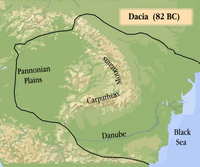
Transylvania within the Dacian Kingdom, during the rule of Burebista, 82 BC, stretching from the Black Sea to the Adriatic and from the Balkan Mountains to Bohemia.[22]
In its ancient history, the territory of Transylvania belonged to a variety of empires and states, including the Celts, Scythians, the Kingdom of Dacia and the Roman Empire.
The Kingdom of Dacia was in existence at least as early as the beginning of the 2nd century BC when, Rubobostes, a Dacian king from the territory of present-day Transylvania, undertook control of the Carpathian basin by defeating the Celts who previously held power in the region.
Dacia reached its maximum extent under the rule of Burebista. The area now constituting Transylvania was the political center of the ancient Kingdom of Dacia, where several important fortified cities were built; among them was the capital Sarmizegetusa, located near the current Romanian town of Hunedoara.

Porta Praetoria at Porolissum, Dacia (modern Transylvania, Romania)
In 101-102 and 105-106 AD, Roman armies under the Emperor Trajan fought a series of military campaigns to subjugate the wealthy Dacian Kingdom. By 106, under Trajan they succeeded in subduing the southern and central regions of Dacia. After the conquest, the Romans seized an enormous amount of wealth (the Dacian Wars were commemorated on Trajan's Column in Rome) and immediately started to exploit the Dacian gold and salt mines located in today's territory of Transylvania. Roman influence was broadened by the construction of modern roads and some existing major cities such as Ulpia Traiana Sarmizegetusa and Dierna (today Orşova) became Roman colonies. The new province was divided under Hadrian: Dacia Superior, corresponding roughly to Transylvania and Dacia Inferior, similar to the region of South Romania (Walachia). During Antoninus Pius (138-161) the same territory was included in the provinces Dacia Porolissensis (capital at Porolissum) and Dacia Apulensis (capital at Apulum, today Alba-Iulia city in Romania). The Romans built new mines, roads and forts in the province. Colonists from other Roman provinces were brought in to settle the land, founding the cities of Apulum (now Alba Iulia), Napoca (now Cluj-Napoca), Ulpia Traiana Sarmizegetusa and Aquae. During the Roman administration, Christianity entered into the current territory of Transylvania from neighboring Roman provinces where, according to the tradition of the Romanian Orthodox Church, St. Andrew preached.
The Migration period[]

The Biertan Donarium - an early Christian votive object of early 4th century. The inscription in Latin reads "EGO ZENOVIUS VOTUM POSVI" with approximate translation "I, Zenovius, offered this gift"
Due to increasing pressure from the Visigoths,[23] the Romans abandoned the province during the reign of the Emperor Aurelian in 271. Its subsequent history is controversial. The theory of Daco-Romanian continuity asserts that as across much of Europe, a period of chaos and conquests followed after the collapse of Roman rule. Archeological research shows however that many of the Roman cities continued to exist with additional fortifications. It is also asserted that Christianity survived, based on the large number of artifacts discovered. The theory refers with emphasis to a donarium from Biertan (4th century) having the inscription "Ego Zenovius votvm posui" (I, Zenovie, offered this). The Migration theory denies that any significant Romanized population continued to exist in the former province after its occupation by the Visigoths. It is asserted that the rare and isolated Latin inscriptions may be attributed to slaves captured by the Goths in the territory of the Roman Empire and even these disappear within a few decades. The Goths themselves were Christians, so Christian artifacts do not prove the continuity of a Romanized population.

Gepid artifact from the Apahida royal tomb
The territory fell under the control of the Visigoths and Carpians until they were, in their turn, displaced and subdued by the Huns after 376. After the disintegration of Attila's empire, the Huns were succeeded by the Gepids, who were defeated by the Eurasian Avars who ruled the region until around 800 AD. During the Avar rule, after the 6th century, the region was influenced by massive Slavic immigration.
It is subject of controversy whether elements of the mixed Daco–Roman population survived in Transylvania through the Dark Ages (becoming the ancestors of modern Romanians) or the first Vlachs appeared in the area in the 13th century after a northward migration from the Balkan Peninsula. There is an ongoing scholarly debate over the ethnicity of Transylvania's population before the Hungarian conquest (see Origin of the Romanians).
At the beginning of the 9th century, Transylvania, along with eastern Pannonia, was under the control of the First Bulgarian Empire. After a brief period of Bulgarian rule, the territory was partially under Byzantine control.
There were also periods when autonomous political entities arose under the control of the Byzantine and the Bulgarian Empire.[24]
Hungarian rule[]
The Hungarians (Magyars) conquered the area at the end of the 9th century and firmly established their control over it in 1003, when king Stephen I, according to legend, defeated the native prince entitled or named Gyula.[10][11][12][13]
According to the theory of Daco-Romanian continuity, Hungary took possession of Transylvania in the 11th century, a territory that probably had a mixed but basically Romanian population.[25] According to Hungarian historiography, the population of Transylvania at the time of the Hungarian conquest in 895-96 consisted of Slavs and probably some Eurasian Avars. In this view, Romanians did not live in Transylvania in that period and appeared there only in the 12th century.

Peasants of Hodod, Transylvania
After the occupation, the Hungarian crown encouraged immigration in order to counter invasion. Most important was the settlement of the Székelys and the Germans, who came in the 12th century. As a political entity, (Southern) Transylvania is mentioned from the 12th century as a county (Alba) of the Kingdom of Hungary (M. princeps ultrasilvanus - comes Bellegratae). Transylvania's seven counties were brought under the voivode's (count of Alba Iulia) rule in 1263. Although Transylvania was part of the Kingdom of Hungary, it retained wide autonomous privileges[26] and status[27] and after 1526 became a fully autonomous principality[27] under nominal Ottoman suzerainty.
Since medieval times, the population of the region has been a mixture of ethnic Romanians (historically known as Vlachs), Hungarians, the ethnic Hungarian[28] Székely people, Germans (known as Saxons), Bulgarians (see Şchei, Şcheii Braşovului, Banat Bulgarians), Armenians (especially in Gherla (Armenopolis), Gheorgheni and Târnăveni), Jews, and Roma (known as Gypsies or "tatars" - Tatern in Transylvanian Saxon or tătăraşi in Romanian).

Transylvanian Saxons
Between 1003 and 1526, Transylvania was a voivodeship of the Kingdom of Hungary, led by a voivode appointed by the Hungarian King. After the Battle of Mohács in 1526, Transylvania became part of the Eastern Hungarian Kingdom which, in 1571, was transformed into the Principality of Transylvania (1571–1711) ruled primarily by Calvinist Hungarian princes. For most of this period, Transylvania, maintaining its internal autonomy, was under the suzerainty of the Ottoman Empire.
The early 11th century was marked by the conflict between King Stephen I of Hungary and his uncle Gyula, the ruler of Transylvania. The Hungarian ruler was successful in these wars, and Transylvania was incorporated into the Christian Kingdom of Hungary. The Transylvanian Christian bishopric and the comitatus system were organised. By the early 11th century, the ethnic Hungarian Székely were established in southeastern Transylvania[29] as a border population of ready warriors, and in the 12th and 13th centuries, the areas in the south and northeast were settled by German colonists called Saxons.[29] Romanians maintained control over a few autonomous regions called 'terrae': Făgăraş, Amlas, Haţeg, Maramureş, Lapus. However, the autonomy was taken by the end of Árpád dynasty in 1301.
In 1241–1242, during the Mongol invasion of Europe, Transylvania was among the territories devastated by the Golden Horde. A large portion of the population perished. This was followed by a second Mongol invasion in 1285, led by Nogai Khan. To escape these depredations, Wallachian (Romanian) settlers moved into the mountainous districts of the Carpathians.[14] The rulers of the Kingdom of Hungary established programs of colonization in eastern and southern Hungary. Saxon Germans, Székelys, Slavs, and Wallachians settled in the peripheral areas which had suffered so greatly from the Mongol invasion.[14]

Diocesan division of Transylvania in the 13th century within the Kingdom of Hungary
Following this devastation, Transylvania was reorganized according to a class system of Estates, which established privileged groups (universitates) with power and influence in economic and political life, as well as along ethnic lines. The first Estate was the lay and ecclesiastic aristocracy, ethnically heterogeneous, but undergoing a process of homogenization around its Hungarian nucleus. The other Estates were Saxons, Székelys and Romanians (or Vlachs - Universitas Valachorum), all with an ethnic and ethno-linguistic basis (Universis nobilibus, Saxonibus, Syculis et Olachis). The general assembly (congregatio generalis) of the four Estates had few genuine legislative powers in Transylvania, but it sometimes took measures regarding order in the country.
After the Decree of Turda (1366), which openly called for action "to expel or to exterminate in this country malefactors belonging to any nation, especially Romanians" in Transylvania,[30] the only possibility for Romanians to retain or access nobility was through conversion to Roman Catholicism. Some Orthodox Romanian nobles converted, being integrated in the Hungarian nobility, but the most of them declined, thus losing their status and privileges.[31]
In some regions in the north (Maramureş) and south (Ţara Haţegului, Făgăraş, Banat) where Romanians formed a majority of the population,[32] the Orthodox Romanian ruling class of nobilis kenezius (classed as lesser and middle nobility in the Kingdom as a whole) enjoyed a period of prosperity at the end of the 14th and the beginning of the 15th century during the time of transylvanian voivode Stibor of Stiboricz and reflected in the reconstruction and decoration of some Orthodox churches. A Romanian archbishop is mentioned in 1377 in Transylvania; other Orthodox hierarchs were established in St. Michael's monastery at Feleac, near Cluj and Peri.[32] Nevertheless, because of the gradual loss of a nobility of their own, Romanians were no longer able to keep their Universitas Valachorum.
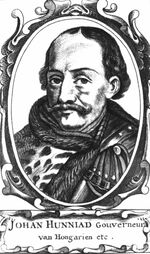
John Hunyadi
A key figure to emerge in Transylvania in the first half of the 15th century was John Hunyadi/János Hunyadi[33][34]/Iancu de Hunedoara, a native of Transylvania, born in a family of Romanian origins.[32] (According to the usage of Hungarian noblemen of the time, John (also Iancu or János) took his family name after his landed estate.[33]) He was one of the greatest military figures of the time, being Hungarian general, voivode of Transylvania[33] and then governor of the Kingdom of Hungary[32][33] from 1446 to 1452. He was a Transylvanian noble of Romanian origin[32] some sources indicating him as the son of Voicu or Vajk, a Romanian boyar from Wallachia.[35] Hungarian historians claim that his mother was Erzsébet Morzsinay, the daughter of a Hungarian noble family.[36] His fame was built in the effective wars of defence against the Turkish attacks, waged from 1439. With his private mercenary army, John rapidly rose to the heights of power. His military campaigns against the Ottoman Empire brought him the status of Transylvanian governor in 1446 and papal recognition as the Prince of Transylvania in 1448. Continuing his military activity, he won an important victory at Belgrade in 1456, which halted the Ottomans' advance for several decades, but died shortly afterwards during an epidemic.
After the suppression of the Budai Nagy Antal-revolt in 1437, the political system was based on Unio Trium Nationum (The Union of the Three Nations). According to the Union, which was explicitly directed against serfs and other peasants, society was ruled by three privileged Estates of the nobility (mostly ethnic Hungarians), the Székelys, also an ethnic Hungarian people who primarily served as warriors, and the ethnic German, Saxon burghers.
The only possibility for Romanians to retain or access nobility in Hungarian Transylvania was through conversion to Catholicism. Some Orthodox Romanian nobles converted, becoming integrated into the Hungarian nobility. These circumstances marked the beginning of a conflict between ethnic Hungarian Catholics and ethnic Romanian Orthodox (and ethnic Romanian Greek Catholics also) in the territory of Transylvania which in some regions remains unresolved to this day.[37]
Principality of Transylvania[]

The medieval Kingdom of Hungary was divided into three parts after the Battle of Mohács (1526) which led to the formation of the semi-independent Principality
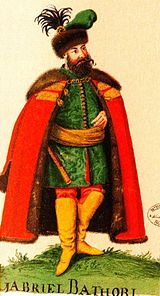
Gabriel Báthory, prince of Transylvania
The 16th century in Southeastern Europe was marked by the struggle between the Muslim Ottoman Empire and the Catholic Habsburg Empire. After the Hungarian defeat at Mohács, Hungary was divided between the Ottoman and Habsburg empires.[38]
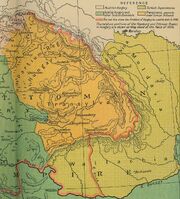
Principality of Transylvania
Transylvania became an Ottoman vassal state, where native princes, who paid the Turks tribute, ruled with considerable autonomy.[38] Austrian and Turkish influences vied for supremacy for nearly two centuries. It is this period of independence and Turkish influence that contributed to Transylvania being seen as exotic in the eyes of Victorians such as Bram Stoker, whose novel Dracula was published in 1897.[39]
Because Transylvania was now beyond the reach of Catholic religious authority, Protestant preaching such as Lutheranism and Calvinism were able to flourish in the region. In 1568, the Edict of Turda proclaimed four religious expressions in Transylvania - Latin Rite or Eastern Rite Catholicism, Lutheranism, Calvinism and Unitarianism (Unitarian Church of Transylvania), while Eastern Orthodoxy, which was the confession of almost the entire ethnic Romanian part of the population, was proclaimed as "tolerated" (tolerata).
The Báthory, a Hungarian noble family, began to rule Transylvania as princes under the Ottomans in 1571, and briefly under Habsburg suzerainty until 1600. The latter period of their rule saw a four-sided conflict in Transylvania involving the Transylvanian Báthorys, the emerging Austrian Empire, the Ottoman Empire, and the Romanian voivoideship (province) of Wallachia. This included almost a year period of Romanian rule after the conquest of the territory by Wallachian voivod Michael the Brave. As he subsequently extended his rule over Moldavia, Michael the Brave unified all the territories where Romanians lived, rebuilding the mainland of the ancient Kingdom of Dacia.[40] The prince, who managed for a short time in 1600 to rule the three territories that were to be united some three centuries later in modern Romania, begins to be perceived as a unifier only towards the middle of the 19th century. Such an interpretation is completely lacking in the historiography of the 17th century chroniclers, and even in that of the Transylvanian School around 1800. In Michael's time, the concept of the Romanian nation and the desire for unification did not exist,[41] and the absence of any national element in Michael's politics, holding that Michael's lack of desire to join the principalities' administrations proved his actions were not motivated by any such concept.[42] Moreover, the princes of Transylvania never developed a Romanian national identity, the majority not being of Daco-Roman descent, according to the American author George W. White.[43]
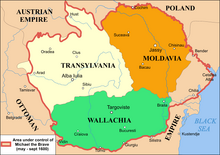
Transylvania was united with Wallachia and Moldavia under the rule of Michael the Brave for almost a year in 1599-1600
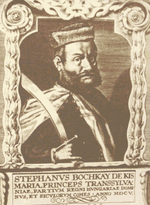
Stephen Bocskay
The Calvinist magnate of Bihar county Stephen Bocskai managed to obtain, through the Treaty of Vienna (June 23, 1606), religious liberty and political autonomy for the region, the restoration of all confiscated estates, the repeal of all "unrighteous" judgments, as well as his own recognition as independent sovereign prince of an enlarged Transylvania. Under Bocskai's successors, most notably Gabriel Bethlen and George I Rákóczi, Transylvania passed through a golden age for many religious movements and for the arts and culture. It became one of the few European States where Roman Catholics, Calvinists, Lutherans and Unitarians lived in peace, although Orthodox Romanians continued to be denied equal recognition.
This golden age and relative independence of Transylvania ended with the reign of George II Rákóczi. The prince, coveting the Polish crown, allied with Sweden and invaded Poland in spite of the Turkish Porte clearly prohibiting any military action. Rákóczi's defeat in Poland, combined with the subsequent invasions of Transylvania by the Turks and their Crimean Tatar allies, the ensuing loss of territory (most importantly, the loss of the most important Transylvanian stronghold, Oradea) and diminishing manpower led to the complete subordination of Transylvania, which became a powerless vassal of the Ottoman Empire.
Habsburg rule[]
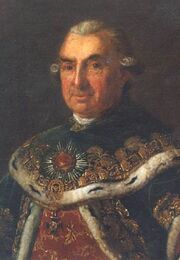
Samuel von Brukenthal

A busy market scene in Transylvania, 1818
The Habsburgs acquired the territory shortly after the Battle of Vienna in 1683. The Habsburgs, however, recognized the Hungarian sovereignty over Transylvania,[14] while the Transylvanians recognized the suzerainty of the Habsburg emperor Leopold I (1687), and the region was officially attached to the Habsburg Empire, separated in all but name[15][16] from Habsburg controlled Hungary[17][18][19] and subjected to the direct rule of the emperor's governors.[20] In 1699 the Turks legally conceded their loss of Transylvania in the Treaty of Karlowitz; however, anti-Habsburg elements within the principality only submitted to the emperor in the 1711 Peace of Szatmár. After the Ausgleich of 1867 the region was fully reabsorbed into Hungary [11][13] as a part of the newly established Austro-Hungarian Empire.
After the defeat of the Ottomans at the Battle of Vienna in 1683, the Habsburgs gradually began to impose their rule on the formerly autonomous Transylvania. Apart from strengthening the central government and administration, the Habsburgs also promoted the Roman Catholic Church, both as a uniting force and also as an instrument to reduce the influence of the Protestant nobility. In addition, they tried to persuade Romanian Orthodox clergymen to join the Greek (Byzantine Rite) Catholic Church in union with Rome. As a response to this policy, several peaceful movements of the Romanian Orthodox population advocated freedom of worship for all the Transylvanian population, especially the movements led by Visarion Sarai, Nicolae Oprea Miclăuş and Sofronie of Cioara. Additional Germans settled in the principality under official colonization schemes and a large number of Romanians, fleeing the Turkish rule in their own principalities, also moved in to occupy vacant lands.[14]
From 1711, the princes of Transylvania were replaced with imperial governors[16][20] and in 1765 Transylvania was declared a Grand Principality of Transylvania, further consolidating its special separate status within the Habsburg Empire established by the Diploma Leopoldinum in 1691.[19] Hungarian historiography sees this as a mere formality.[44][45] Within the Habsburg-controlled Kingdom of Hungary there was a separate administrative Hungary and Transylvania.

The Transylvanian Principality in 1857
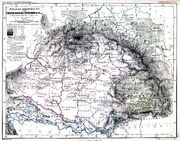
Administrative map of Hungary, Galicia and Transylvania in 1862
The revolutionary year 1848 was marked by a great struggle between the Hungarians, the Romanians and the Habsburg Empire. The Hungarians promised for Romanians the abolition of serfdom for their support against Austria.[29] The Romanians rejected the offer and instead rose against the Hungarian national state.[29] Warfare erupted in November with both Romanian and Saxon troops, under Austrian command, battling the Hungarians led by the Polish-born general Józef Bem in Transylvania. He carried out a sweeping offensive through Transylvania, and Avram Iancu managed to retreat to the harsh terrain of the Apuseni Mountains, mounting a guerrilla campaign on Bem's forces. After the intervention by the armies of Tsar Nicholas I of Russia, Bem's army was defeated decisively at the Battle of Timişoara (Temesvár, Hun.) on 9 August 1849.
Having quashed the revolution, Austria imposed a repressive regime on Hungary, ruled Transylvania directly through a military governor and granted citizenship to the Romanians.
The 300-year long special separate status came was terminated by the Austro-Hungarian Compromise of 1867, which established the dual monarchy and reincorporated Transylvania into Hungary. On 20 June 1867, the Diet was dissolved by royal decree, and an ordinance abrogated the legislative acts of the Cluj-Napoca provincial assembly. The department of the interior inherited the responsibilities of the Transylvanian Gubernium, and the government reserved the right to name Transylvania's royal magistrates as well as the Saxon bailiff of the Universitas Saxorum. Hungarian legislation also came to supersede the Austrian code of civil procedure, penal law, commercial law, and regulations for bills of exchange.
The new unity of Austria-Hungary created a process of Magyarization affecting Transylvania's Romanians[46] and German Saxons.[47] After the Ausgleich of 1867, when an autonomous government for the Kingdom of Hungary was formed within Austria-Hungary, the importance of Transylvania as a core territory was once again illustrated when Hungarian leaders successfully demanded and secured Transylvania's return to the Hungarian Kingdom. By the 1890s, the Hungarians government began implementing vigurous Magyarization policies in an attempt to integrate the territories of the Hungarian Kingdom. Those Magyarization policies were primarily directed at Transylvania.[48] In an important sense, Transylvania was the historical breeding ground of Hungarian romantic nationalism. Its Magyar-led anti-Habsburg struggles preceded the popular nationalism that emerged among the Pannonian Magyars in the early 19th century. Even after the revolution of 1848 and the 1867 Ausgleich separating Austria from Hungary, Transylvanian aristocrats continued to exert a high degree of power since Hungary adopted what some historians call an official nationalism.[49]
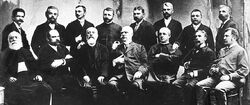
The signers of the Transylvanian Memorandum
Although Romanians formed the majority of Transylvania's population (59%), they had not been awarded legal status as a nation. In 1892 the leaders of the Romanians of Transylvania sent a Memorandum to the Austro-Hungarian Emperor-King Franz Joseph, asking for equal ethnic rights with the Hungarians, and demanding an end to persecutions and Magyarization attempts. Franz Josef forwarded the memorandum to Budapest, and the authors were tried for "homeland betrayal" in May 1894, being sentenced to long prison terms.
- Clickable Map of the Grand Duchy of Transylvania
Template:GrandDuchyOfTransylvania,1769-73
Union with Romania[]
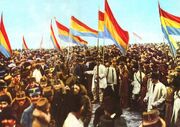
The National Assembly in Alba Iulia (December 1, 1918)
Following defeat in World War I, Austria-Hungary began to disintegrate. The ethnic Romanian majority elected representatives, who then proclaimed Union with the Kingdom of Romania on December 1, 1918. The Proclamation of Union of Alba Iulia was adopted by the Deputies of the Romanians from Transylvania, and supported one month later by the vote of the Deputies of the Saxons from Transylvania. In 1920, the Allies confirmed the union in the Treaty of Trianon. Hungary protested as over 1,600,000 Hungarian people[21] were living in the area in question, mainly in Székely Land of Eastern Transylvania, and along the newly created border, which was partially drawn through areas with compact Hungarian population. In August 1940, in the midst of World War II, Hungary regained about 40% of Transylvania by the Vienna Award, with the aid of Germany and Italy. The territory, however, was returned to Romania in 1945; this was confirmed in the 1947 Paris Peace Treaties.[11]
As Austria-Hungary disintegrated at the end of World War I, the nationalities living there proclaimed their independence from the empire. The 1228-member National Assembly of Romanians of Transylvania and Hungary, headed by leaders of Transylvania's Romanian National Party and Social Democratic Party, passed a resolution calling for unification of all Romanians in a single state on 1 December in Alba Iulia.[50] This was approved by the National Council of the Germans from Transylvania and the Council of the Danube Swabians from the Banat, on 15 December in Mediaş. In response, the Hungarian General Assembly of Cluj reaffirmed the loyalty of Hungarians from Transylvania to Hungary on December 22, 1918. (See also: Union of Transylvania with Romania) The Treaty of Versailles placed Transylvania under the sovereignty of Romania, an ally of the Triple Entente, and the Treaty of St. Germain (1919) and the Treaty of Trianon (signed in June 1920) further elaborated the status of Transylvania and defined the new border between the states of Hungary and Romania.[51][52] King Ferdinand I of Romania and Queen Maria of Romania were crowned at Alba Iulia in 1922 as King and Queen of all Romania.

Kingdom of Romania historical provinces after World War I
One of the new administration's objectives was to enforce the Romanianization of Transylvania in a social-political fashion, after centuries of Hungarian rule.[53] The goal was to create a Romanian middle and upper class that would be promoted to assume the role of the former Hungarian ruling elites. The Hungarian language was expunged from administration, a field that it solely occupied before, and all place-names were Romanianized.[54] About 197,000 Transylvanian Hungarians fled to Hungary between 1918 and 1922,[55] and a further group of 169,000 emigrated over the remainder of the interwar period.[54] In 1930, Romanians formed the majority of the Transylvanian population (58.2%, up from 53.8% in 1910), while Magyars (26.7%, down from 31.6% in 1910), Germans (9.8%, down from 10,7% in 1910) and Jews (3.2% in 1930, counted as Magyars in 1910) were minority groups.[56] The expropriation of the estates of Magyar magnates, the distribution of the lands to the Romanian peasants, and the policy of cultural Romanianization that followed were major causes of friction between Hungary and Romania.[29]
World War II and Communist Romania[]
In August 1940, the second Vienna Award granted the Northern Transylvania to Hungary. After the Treaty of Paris (1947), at the end of World War II, the territory was returned to Romania. The post-World War II borders with Hungary, agreed on at the Treaty of Paris, were identical with those set out in 1920.
After World War II and especially after the fall of Communism, almost all of the German-speaking population left Transylvania, with most of them settling in Germany.
Recent history (1989 to present)[]

Location of Transylvania (including Banat, Crişana and Maramureş) in Europe.
After the Romanian Revolution of 1989, some ethnic Hungarians began advocating greater autonomy for the Székely Region (the counties of Harghita and Covasna and part of Mureş County) where ethnic Hungarians outnumber ethnic Romanians.[57][58] There have been tensions in Transylvania between Romanians and ethnic Hungarians who wanted autonomy in the 1990s.[58][59] The Hungarians said they were the target of attacks by Romanian politicians and news organizations.[59] Autonomy advocates claimed the attacks were an attempt to forcibly assimilate the Hungarian minority of 1.43 million people, or 6.6% of the Romanian population (according to the census of 2002). Some ethnic Romanians chided the autonomy advocates because of their refusal to integrate and in some cases for their inability to speak Romanian.[59]
In 1996 Romania and Hungary signed a Basic Treaty on Understanding, Cooperation, and Good-Neighborliness, aiming to protect and develop the ethnic, cultural, linguistic and religious identity of the Hungarian minority in Romania and the Romanian minority in Hungary[60] receiving good feedback from US and EU members in the context of NATO enlargement.[61][62]

Hungarian minority in Transylvania
In 2003, the Székely National Council was founded - a local Hungarian group with autonomy as its stated goal.[58] Unlike the Kosovars, Székely pro-autonomy organizations seek autonomy within Romania rather than complete independence, leaving foreign policy and national defense in the hands of the government in Bucharest.[58]
Ethnic Hungarians in Transylvania have traditionally voted for the Democratic Union of Hungarians in Romania, a centrist organization with a long record of cooperating with Romanian parties, both in government and in opposition. The more radical Hungarian Civic Party positions itself as an alternative and has advocated more vocally for the autonomy of the Székely region.[58] The ethnic-Hungarian politician, László Tőkés, one of the party's leaders, holds that Romanian and Hungarian authorities should reach an agreement regarding the status of the Hungarian community and the Székely Land.[63]
However, relations between Romania and Hungary have improved significantly in the 2000s.[64] The governments of Hungary and Romania held their second annual joint session in 2006. The main objective is convergence of Hungarian and Romanian National Development Plans. In particular they are keen to increase co-operation aimed at improving their absorption capacity of EU funds and to ensure development in line with EU standards. The two countries are also working closely on policies to promote the welfare of ethnic Romanians living in Hungary and ethnic Hungarians in Romania.[64]
Geography and ethnography[]
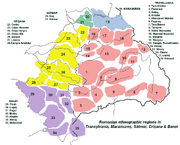
Romanian ethnographic regions (Transylvania-red; Maramureş-blue; Sǎtmar-green; Crişana-yellow; Banat-purple)
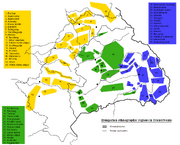
Hungarian ethnographic regions (King's Pass - yellow; Western Transylvania - green; Eastern Transylvania - blue)
The Transylvanian plateau, 300 to 500 metres (1,000-1,600 feet) high, is drained by the Mureş, Someş, Criş, and Olt rivers, as well as other tributaries of the Danube. This core of historical Transylvania roughly corresponds with nine counties of modern Romania. Other areas to the west and north, which also united with Romania in 1918 (inside the border established by peace treaties in 1919-20), are since that time widely considered part of Transylvania.
- Transylvania proper:
- Amlaş
- Ţara Bârsei (Burzenland)
- Chioar
- Făgăraş
- Haţeg
- Kalotaszeg (Ţara Călatei)
- Mărginimea Sibiului
- The Transylvanian Plain (Câmpia Transilvaniei/Mezőség)
- Székely Land
- Ţara Moţilor
- Ţara Năsăudului (Nösnerland)
- Ţinutul Pădurenilor
- Banat
- Crişana
- Ţara Zarandului
- Maramureş
- Ţara Lǎpuşului
- Ţara Oaşului
See also Administrative divisions of the Kingdom of Hungary. In common reference, the Western border of Transylvania has come to be identified with the present Romanian-Hungarian border, settled in the Treaty of Trianon, although geographically the two are not identical.
Administrative divisions[]
The area of the historical Voivodeship is 21,292 sq mi/55,146 km2.
The region granted to Romania in 1920 covered 23 counties including nearly 102,200 km² (102,787–103,093 in Hungarian sources and 102,200 in contemporary Romanian documents) now due to the several administrative reorganisations Transylvania covers 16 present-day counties (Romanian: judeţ) which include nearly 99,837 km² of central and northwest Romania. The 16 counties are:
- Alba
- Arad
- Bihor
- Bistriţa-Năsăud
- Braşov
- Caraş-Severin
- Cluj
- Covasna
- Harghita
- Hunedoara
- Maramureş
- Mureş
- Sălaj
- Satu Mare
- Sibiu
- Timiş
The most populous cities (as of 2011 census):[65]
- Cluj-Napoca (309,136)
- Timişoara (303,708)
- Braşov (227,961)
- Oradea (183,123)
- Arad (147,992)
- Sibiu (137,026)
- Târgu Mureş (127,849)
- Baia Mare (114,925)
- Satu Mare (94,948)
Population[]
Historical population[]

Ethno-linguistic map of Austria–Hungary, 1910.

Hungarian and Romanian language newspapers published in Cluj.
Official censuses with information on Transylvania's population have been conducted since the 18th century. On May 1, 1784 the Emperor Joseph II called for the first official census of the Habsburg Empire, including Transylvania. The data was published in 1787, and this census showed only the overall population (1,440,986 inhabitants).[66] Fényes Elek, a 19th century Hungarian statistician, estimated in 1842 that in the population of Transylvania for the years 1830-1840 the majority were 62.3% Romanians and 23.3% Hungarians.[67]
The first official census in Transylvania that made a distinction between nationalities (distinction made on the basis of mother tongue) was performed by Austro-Hungarian authorities in 1869, distributed among the ethnic groups as follows: Romanians 59.0%, Hungarians 24.9%, Germans 11.9%.
In the last quarter of the 19th century, the Hungarian population of Transylvania increased from 24.9% in 1869 to 31.6%, as indicated in the 1910 Hungarian census. At the same time, the percentage of Romanian population decreased from 59.0% to 53.8% and the percentage of German population decreased from 11.9% to 10.7%, for a total population of 5,262,495. Magyarization policies greatly contributed to this shift.
The percentage of Romanian majority has significantly increased since the union of Transylvania with Romania after World War I in 1918. The proportion of Hungarians in Transylvania was in steep decline as more of the region's inhabitants moved into urban areas, where the pressure to assimilate and Romanianize was greater.[68] The expropriation of the estates of Magyar magnates, the distribution of the lands to the Romanian peasants, and the policy of cultural Romanianization that followed the Treaty of Trianon were major causes of friction between Hungary and Romania.[69] Other factors include the emigration of non-Romanian peoples, assimilation and internal migration within Romania (estimates show that between 1945 and 1977, some 630,000 people moved from the Old Kingdom to Transylvania, and 280,000 from Transylvania to the Old Kingdom, most notably to Bucharest).[70]
Current population[]
The 2002 census classified Transylvania as the entire region of Romania west of the Carpathians. This region has a population of 7,221,733, with a large Romanian majority (75.9%). There are also sizeable Hungarian (19.6%), Roma (3.3%), German (0.7%) and Serb (0.1%) communities.[71][72] The ethnic Hungarian population of Transylvania, largely composed of Székely, form a majority in the counties of Covasna and Harghita.
Economy[]
Transylvania is rich in mineral resources, notably lignite, iron, lead, manganese, gold, copper, natural gas, salt and sulfur.
There are large iron and steel, chemical, and textile industries. Stock raising, agriculture, wine production and fruit growing are important occupations. Timber is another valuable resource.
IT, electronics and automotive industries are important in urban and university centers like Cluj-Napoca (Nokia), Timişoara (Alcatel-Lucent, Flextronics and Continental AG), Braşov, Sibiu, Oradea and Arad.
Native brands include: Roman of Braşov (trucks and buses), Azomureş of Târgu Mureș (fertilizers), Terapia of Cluj-Napoca (pharmaceuticals), Banca Transilvania of Cluj-Napoca (finance), Romgaz and Transgaz of Mediaş (natural gas), Jidvei of Alba county (alcoholic beverages), Timişoreana of Timişoara (alcoholic beverages) and others.
Transylvania accounts for around 35% of Romania's GDP, and has a GDP per capita (PPP) of around $11,500, around 10% higher than the Romanian average.
Tourist attractions[]

Turda salt mine
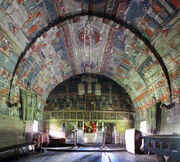
Interior of the wooden church of Cizer in the Ethnographic Museum of Transylvania.

Fundata in Braşov County
- Bran Castle, also known as Dracula's Castle
- The medieval cities of Alba Iulia, Cluj-Napoca, Sibiu (European Capital Of Culture in 2007), Târgu Mureş and Sighişoara (UNESCO World Heritage Site and allegedly birthplace of Vlad Dracula)
- The city of Braşov and the nearby Poiana Braşov ski resort
- The city of Hunedoara with the 14th century Hunyadi Castle
- The citadel and the Art Nouveau city centre of Oradea
- The Densus Church, the oldest church in Romania in which services are still officiated[73]
- The Dacian Fortresses of the Orăştie Mountains, including Sarmizegetusa (UNESCO World Heritage Site)
- The Maramureş region including:
- The Merry Cemetery of Săpânţa (the only of that kind in the world)
- The Wooden Churches (UNESCO World Heritage Site)
- The cities of Baia Mare and Sighetu Marmaţiei.
- The villages on the Iza, Mara, and Viseu Valleys.
- The Saxon fortified churches (UNESCO World Heritage Site)
- Romanian traditions and folk culture, ASTRA National Museum Complex, Sibiu
- Hungarian traditions and folk culture
- The cafe culture,[74] street theatre and cosmopolitan society of Sibiu, Cluj-Napoca and Timișoara
- The Apuseni Mountains:
- The Rodna Mountains.
Festivals and events[]
Film festivals[]
- ALTER-NATIVE - International Short Film Festival, Târgu-Mureş
- Astra Film Festival, Sibiu
- Comedy Cluj, Cluj-Napoca
- Gay Film Nights, Cluj-Napoca
- Timishort, Timişoara
- Transilvania International Film Festival, Cluj-Napoca
- Lună Plină, - Horror and Phantasy Film Festival, Biertan
Music festivals[]
- Festivalul Plai, Timişoara
- Golden Stag Festival, Braşov
- Gărâna Jazz Festival, Gărâna
- Peninsula / Félsziget Festival, Târgu-Mureş - Romania's biggest music festival
- Toamna Muzicală Clujeană, Cluj-Napoca
- Transilvania International Guitar Festival, Cluj-Napoca
Others[]
- Sighişoara Medieval Festival, Sighişoara
Historical coat of arms of Transylvania[]
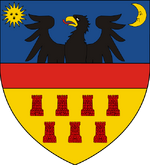
The historical arms of Transylvania (1659).
The first heraldic representations of Transylvania date from the 16th century. One of the predominant early symbols of Transylvania was the coat of arms of Sibiu city. In 1596 Levinus Hulsius created a coat of arms for the imperial province of Transylvania, consisting of a shield party per fess, with a rising eagle in the upper field and seven hills with towers on top in the lower field. He published it in his work "Chronologia", issued in Nuremberg the same year. The seal from 1597 of Sigismund Báthory, prince of Transylvania, reproduced the new coat of arms with some slight changes: in the upper field the eagle was flanked by a sun and a moon and in the lower field the hills were replaced by simple towers.[76]
The seal of Michael the Brave from 1600 depicts the territory of the former Dacian kingdom: Wallachia, Moldavia and Transylvania:[77]
- The black eagle (Wallachia)
- The auroch head (Moldavia)
- The seven hills (Transylvania).
- Over the hills there were two rampant lions affronts, supporting the trunk of a tree, as a symbol of the reunited Dacian Kingdom.[77]
The Diet of 1659 codified the representation of the privileged nations in Transylvania's coat of arms. It depicted a black turul on a blue background, representing the Hungarian nobility,[78] a Sun and the Moon representing the Székelys, and seven red towers on a yellow background representing the seven fortified cities of the Transylvanian Saxons. The red dividing band was originally not part of the coat of arms.
Currently, unlike the counties included in it, the region of Transylvania does not have its own official coat of arms. Nonetheless, the historical coat of arms is currently present in the coat of arms of Romania, alongside the traditional coats of arms of the rest of Romania's historical regions.
Gallery[]
Transylvania in fiction[]

Lugosi as Dracula
Following the publication of Emily Gerard's The Land Beyond the Forest (1888), Bram Stoker wrote his gothic horror novel Dracula in 1897, using Transylvania as a setting. With its success, Transylvania became associated in the English-speaking world with vampires. Since then it has been represented in fiction and literature as a land of mystery and magic. For example, in Paulo Coelho's novel The Witch of Portobello, the main character, Sherine Khalil, is described as a Transylvanian orphan with a Romani mother, in an effort to add to the character's exotic mystique. The so-called Transylvanian trilogy of historical novels by Miklos Banffy, The Writing on the Wall, is an extended treatment of the 19th and early 20th century social and political history of the country. The first actor to portray Bram Stoker's Dracula in a film, Bela Lugosi, was born in Transylvania.
Juliet Marillier's young adult fiction Wildwood Dancing, is set in Transylvania and involves the folk tales and the lifestyle of Transylvanians.
See also[]
- Prehistory of Transylvania
References[]
- ^ "Transylvania Society of Dracula Information". Afn.org. 1995-05-29. http://www.afn.org/~vampires/tsd.html. Retrieved 2012-07-30.
- ^ "TRAVEL ADVISORY; Lure of Dracula In Transylvania". The New York Times. 1993-08-22. http://query.nytimes.com/gst/fullpage.html?res=9F0CE6DE143BF931A1575BC0A965958260.
- ^ "Romania Transylvania". Icromania.com. 2007-04-15. http://www.icromania.com/infoTransylvania.asp. Retrieved 2012-07-30.
- ^ Engel, Pál (2001). Realm of St. Stephen: History of Medieval Hungary, 895–1526 (International Library of Historical Studies), page 24, London: I.B. Taurus. ISBN 1-86064-061-3
- ^ A Gazetteer of the World: Or, Dictionary of Geographical Knowledge, Compiled ... - Royal Geographical Society (Great Britain). Books.google.co.uk. http://books.google.co.uk/books?id=_rkNAAAAQAAJ&pg=PA843&dq=clausenburg+1208&hl=co.uk&sa=X&ei=uZ7ET4StO86c-wa-mJyKCg&redir_esc=y#v=onepage&q=clausenburg%201208&f=false. Retrieved 2012-07-30.
- ^ Researches on the Danube and the Adriatic by Andrew Archibald Paton (1861). Contributions to the Modern History of Hungary and Transylvania, Dalmatia and Croatia, Servia and Bulgaria-Brockhaus page 61
- ^ Pascu, Ştefan (1972). "Voievodatul Transilvaniei" I.
- ^ István Lázár: Transylvania, a Short History, Simon Publications, Safety Harbor, Florida, 1996 [1]
- ^ Martyn C. Rady: Nobility, Land and Service in Medieval Hungary, Antony Grove Ltd, Great Britain, 2000 [2]
- ^ a b Gyula - it is possible that during the 10th century some of the holders of the title of gyula also used Gyula as a personal name, but the issue has been confused because the chronicler of one of the most important primary sources (the Gesta Hungarorum) has been shown to have used titles or even names of places as personal names in some cases.
- ^ a b c d e f "Transylvania". Encyclopædia Britannica. Encyclopædia Britannica, Inc.. 2008. http://britannica.com/EBchecked/topic/603323/Transylvania. Retrieved 2008-08-01.
- ^ a b Engel, Pal; Andrew Ayton (2005). The Realm of St Stephen. London: Tauris. p. 27. ISBN 1-85043-977-X. http://books.google.com/?id=vEJNBqanT_8C&pg=PA27.
- ^ a b c d "Transylvania", Microsoft Encarta Online Encyclopedia 2008 http://encarta.msn.com © 1997–2008 Microsoft Corporation. All Rights Reserved.
- ^ a b c d e "International Boundary Study - No. 47 – April 15, 1965 - Hungary – Romania (Rumania) Boundary". US Bureau of Intelligence and Research. http://www.law.fsu.edu/library/collection/LimitsinSeas/IBS047.pdf.
- ^ a b "Diploma Leopoldinum (Transylvanian history)". Britannica.com. http://www.britannica.com/EBchecked/topic/1459175/Diploma-Leopoldinum. Retrieved 2012-07-30.
- ^ a b c "Transylvania (region, Romania)". Britannica.com. http://www.britannica.com/EBchecked/topic/603323/Transylvania. Retrieved 2012-07-30.
- ^ a b Peter F. Sugar. Southeastern Europe Under Ottoman Rule, 1354–1804 (History of East Central Europe), University of Washington Press, July 1983, page 163, http://books.google.com/books?id=LOln4TGdDHYC&pg=PA163&dq=independent+principality+that+was+not+reunited+with+Hungary&lr=
- ^ a b John F. Cadzow, Andrew Ludanyi, Louis J. Elteto, Transylvania: The Roots of Ethnic Conflict, Kent State University Press, 1983, page 79, http://books.google.com/books?id=fX5pAAAAMAAJ&q=diploma+leopoldinum+transylvania&dq=diploma+leopoldinum+transylvania&lr=&pgis=1
- ^ a b c Paul Lendvai, Ann Major. "The Hungarians: A Thousand Years of Victory in Defeat" C. Hurst & Co. Publishers, 2003, page 146; http://books.google.com/books?id=9yCmAQGTW28C&pg=PA146&dq=diploma+leopoldinum+transylvania&lr=
- ^ a b c "Definition of Grand Principality of Transylvania in the Free Online Encyclopedia". Encyclopedia2.thefreedictionary.com. http://encyclopedia2.thefreedictionary.com/Grand+Principality+of+Transylvania. Retrieved 2012-07-30.
- ^ a b (in Hungarian) Történelmi világatlasz [World Atlas of History]. Cartographia. 1998. ISBN 963-352-519-5CM.
- ^ "Britannica Encyclopedia, History of Romania - Antiquity - The Dacians". http://www.britannica.com/EBchecked/topic/508461/Romania/214504/History#ref=ref476941.
- ^ Encyclopædia Britannica, Eleventh Edition
- ^ "6. SOUTHERN TRANSYLVANIA UNDER BULGAR RULE". Mek.oszk.hu. http://mek.oszk.hu/03400/03407/html/49.html. Retrieved 2012-07-30.
- ^ Barbara Jelavich (1983). History of the Balkans: Eighteenth and nineteenth centuries. Cambridge University Press, 1983 ISBN 0-521-27458-3, ISBN 978-0-521-27458-6. p. 20. ISBN 978-0-521-27458-6. http://books.google.com/?id=qR4EeOrTm-0C&pg=PA20&dq=Transylvania+a+territory+that+probably+had+a+mixed+but+basically+Romanian.
- ^ Barbara Jelavich (1983). History of the Balkans: Eighteenth and nineteenth centuries. Cambridge University Press. p. 21. ISBN 0-521-27458-3. http://books.google.com/?id=qR4EeOrTm-0C&pg=PA20&dq=Transylvania+a+territory+that+probably+had+a+mixed+but+basically+Romanian.
- ^ a b Bernard A. Cook (10 January 2001). Europe Since 1945: An Encyclopedia (1st ed.). Routledge. ISBN 978-0-8153-1336-6. http://books.google.com/?id=hafLHZgZtt4C&pg=PA1259&dq=Transylvania+%22autonomous+status+within%22.
- ^ "Szekler". Encyclopædia Britannica. Encyclopædia Britannica, Inc.. 2008. http://www.britannica.com/EBchecked/topic/579333/Szekler. Retrieved 2008-06-30.
- ^ a b c d e The Columbia Encyclopedia, Sixth Edition. Transylvania. Columbia University Press. 2007. http://www.bartleby.com/65/tr/Transylv.html. Retrieved 2009.05.21..
- ^ I. Dani, K. Gündish et al. (eds.) Documenta Romaniae Historica, vol. XIII, Transilvania (1366–1370), Editura Academiei Române, Bucharest 1994, p. 161-162
- ^ Pop I.-A., Nations and Denominations in Transylvania (13th - 16th Century) In Tolerance and Intolerance in Historical Perspective, edited by Csaba Lévai et al., Edizioni PLUS, Università di Pisa, 2003, p. 111 – 125
- ^ a b c d e Matei cazacu (2000). "Transylvania". In Andre Vauchez, Richard Barrie Dobson, Adrian Walford, Michael Lapidge. Encyclopedia of the Middle Ages. Routledge, 2000 ISBN 1-57958-282-6, ISBN 978-1-57958-282-1. ISBN 978-1-57958-282-1. http://books.google.com/?id=om4olQhrE84C&pg=PA1458&dq=maramures+nobility. Cite error: Invalid
<ref>tag; name "Middle" defined multiple times with different content - ^ a b c d "János Hunyadi". Encyclopædia Britannica. Encyclopædia Britannica Inc.. 2008. http://britannica.com/EBchecked/topic/277182/Janos-Hunyadi. Retrieved 2008-07-31.
- ^ "János Hunyadi". Encarta. 2008. http://encarta.msn.com/encyclopedia_761557950/Janos_Hunyadi.html. Retrieved 2008-08-01.
- ^ Enea Silvius Piccolomini, (Pope Pius II), In Europa - Historia Austrialis, BAV, URB, LAT. 405, ff.245, IIII kal. Aprilis MCCCCLVIII, Ex Urbe Roma
- ^ "A Hunyadiaktól karácsonyig" (in Hungarian). Zoltán Balassa. http://web.axelero.hu/kesz/jel/01_12/hunyadiak.htm#10. Retrieved 2008-04-25.
- ^ "Romania Confronts Transylvanian Separatism". Hartford-hwp.com. http://www.hartford-hwp.com/archives/62/456.html. Retrieved 2012-07-30.
- ^ a b A Country Study: Hungary. Federal Research Division, Library of Congress. http://lcweb2.loc.gov/cgi-bin/query/r?frd/cstdy:@field(DOCID+hu0021). Retrieved 2009-01-11.
- ^ "ELENI COUNDOURIOTIS, Dracula and the Idea of Europe". Uni-tuebingen.de. http://www.uni-tuebingen.de/uni/nec/coundour92.htm. Retrieved 2012-07-30.
- ^ Rezachevici, Constantin, Mihai Viteazul et la "Dacie" de Sigismund Báthory en 1595, Ed. Argessis, 2003, 12, p.155-164
- ^ Petre Panaitescu - Mihai Viteazul, Bucureşti, 1936
- ^ Boia 1997, p. 150
- ^ George W. White, Nationalism and territory: constructing group identity in Southeastern Europe, Rowman & Littlefield, 2000, p. 132
- ^ "JOHN HUNYADI: Hungary in American History Textbooks". Andrew L. Simon. Corvinus LIbrary Hungarian History. http://www.hungarian-history.hu/lib/hunyadi/hu03.htm. Retrieved 7 July 2009.
- ^ The Columbia Electronic Encyclopedia Copyright © 2007, Columbia University Press. Licensed from Columbia University Press. All rights reserved. www.cc.columbia.edu/cu/cup/[3]
- ^ Robert Bideleux and Ian Jeffries, A History of Eastern Europe: Crisis and Change, Routledge, 1998. ISBN 0-415-16111-8 hardback, ISBN 0-415-16112-6 paper, p. 368–375.
- ^ Barbara Jelavich (1983). History of the Balkans. Cambridge University Press. ISBN 978-0-521-27459-3. http://books.google.com/?id=Hd-or3qtqrsC&pg=PA72&dq=Transylvania+Magyarization+saxons.
- ^ George W. White, Nationalism and territory, p. 99
- ^ Brett Neilson, Free trade in the Bermuda Triangle and other tales of counterglobalization, 2003, p.63
- ^ "December 1 - Romania National Day". Honorary Consul of Romania in Boston. http://www.roconsulboston.com/Pages/InfoPages/History/December1.html. Retrieved 2008-01-12.
- ^ Bachman, Robert D. (1989). "Romania: A Country Study". http://countrystudies.us/romania/20.htm. Retrieved 2008-01-12.
- ^ "Trianon, Treaty of". Encyclopædia Britannica. http://www.britannica.com/eb/article-9073332/Treaty-of-Trianon. Retrieved 2008-01-12.
- ^ Bugajski, Janusz (1995). Ethnic Politics in Eastern Europe: A Guide to Nationality Policies, Organizations, and Parties. M.E. Sharpe (Washington, D.C.). ISBN 1-56324-283-4, 9781563242830.
- ^ a b Kovrig, Bennett (2000), Partitioned nation: Hungarian minorities in Central Europe, in: Michael Mandelbaum (ed.), The new European Diasporas: National Minorities and Conflict in Eastern Europe, New York: Council on Foreign Relations Press, pp. 19–80.
- ^ Raffay Ernő: A vajdaságoktól a birodalomig. Az újkori Románia története (From voivodeships to the empire. The modern history of Romania). Publishing house JATE Kiadó, Szeged, 1989, pp. 155–156
- ^ Livezeanu, Irina (2000). Cultural Politics in Greater Romania. Cornell University Press. p. 135. ISBN 0-8014-8688-2, 9780801486883.
- ^ "BREAKAWAY ROLE MODEL - Romania: The Magyars in Székely Land". Der Spiegel. 2008-02-22. http://www.spiegel.de/international/europe/0,1518,537008-2,00.html. Retrieved 2008-07-29.
- ^ a b c d e Kulish, Nicholas (2008-04-07). "Kosovo's Actions Hearten a Hungarian Enclave". The New York Times. http://www.nytimes.com/2008/04/07/world/europe/07hungarians.html?_r=1&scp=1&sq=Szekler&st=nyt&oref=slogin. Retrieved 2008-06-30.
- ^ a b c "Hungarians and Romanians At Odds in Transylvania". The New York Times. 1997-12-26. http://query.nytimes.com/gst/fullpage.html?res=9C02E4DB1E3EF935A15751C1A961958260. Retrieved 2008-08-01.
- ^ "TREATY between the Republic of Hungary and Romania on Understanding, Cooperation and Good Neighbourhood". http://hungaryemb.ines.ro/en/tratat.html.
- ^ "U.S. Department Of State, Press Statement:Romania and Hungary Sign Treaty". http://dosfan.lib.uic.edu/ERC/briefing/press_statements/9609/960916ps1.html.
- ^ "UK House Of Commons praises the Treaty between Romania and Hungary". http://www.publications.parliament.uk/pa/cm199697/cmhansrd/vo961101/text/61101w13.htm.
- ^ "Magyar Autonomy, An Issue Romania Needs To Deal With". Mediafax. http://www.mediafax.ro/engleza/magyar-autonomy-an-issue-romania-needs-to-deal-with-official.html?6966;2411796. Retrieved 2008-02-24.
- ^ a b "Foreign and Commonwealth Office, Romania, Country profile". http://www.fco.gov.uk/en/about-the-fco/country-profiles/europe/romania?profile=intRelations&pg=4.
- ^ "HARTA INTERACTIVA Cum s-a schimbat ierarhia marilor orase din tara." (in Romanian). Hotnews.ro. 6 February 2012. http://www.hotnews.ro/stiri-esential-11436960-harta-interactiva-cum-schimbat-ierarhia-marilor-orase-din-tara-mai-ramas-doar-doua-orase-provincie-populatia-peste-300-000-locuitori.htm. Retrieved 17 December 2012.
- ^ http://www.hungarian-history.hu/lib/transy/transy03.htm
- ^ Elek Fényes, Magyarország statistikája, Vol. 1, Trattner-Károlyi, Pest. VII, 1842
- ^ Varga, E. Árpád, Hungarians in Transylvania between 1870 and 1995, Translation by Tamás Sályi, Budapest, March 1999, pp. 30-34
- ^ "Transylvania". Columbia Encyclopedia. http://www.bartleby.com/65/tr/Transylv.html. Retrieved 2008-11-18.
- ^ Varga, E. Árpád, Hungarians in Transylvania between 1870 and 1995, Translation by Tamás Sályi, Budapest, March 1999, p. 31
- ^ 2002 Census official results
- ^ Ethnocultural Diversity Resource Centre database
- ^ "Travel to Romania - Densus Church (Hunedoara)". Romanianmonasteries.org. 2006-05-31. http://www.romanianmonasteries.org/other-monasteries/densus. Retrieved 2012-07-30.
- ^ http://sibiupeople.ro/en/reports/732
- ^ a b "Apuseni Caves". Itsromania.com. http://www.itsromania.com/apuseni-caves.html. Retrieved 2012-07-30.
- ^ Dan Cernovodeanu, Ştiinţa şi arta heraldică în România, Bucharest, 1977, p. 130
- ^ a b "Coat of arms of Dacia (medieval)". http://www.fotw.net/flags/ro-dacia.html.
- ^ Ströhl, Hugo Gerhard (1890). Oesterreichish-Ungarische Wappenrolle. Vienna: Verlag vom Anton Schroll & C°. p. XV.. http://www.austria-lexikon.at/attach/Wissenssammlungen/Symbole/Wappenrolle_Str%C3%B6hl_1890/Wappenrolle_1890_Text.pdf. Retrieved 24 November 2011.
Further reading[]
- This article incorporates text from the Encyclopædia Britannica Eleventh Edition, a publication now in the public domain.
- Patrick Leigh Fermor, Between the Woods and the Water (New York Review of Books Classics, 2005; ISBN 1-59017-166-7). Fermor travelled across Transylvania in the summer of 1934, and wrote about it in this account first published more than 50 years later, in 1986.
- Zoltán Farkas and Judit Sós, Transylvania Guidebook
External links[]
- RTI Radio - Radio Transsylvania International
- Tolerant Transylvania - Why Transylvania will not become another Kosovo, Katherine Lovatt, in Central Europe Review, Vol 1, No 14 27 September 1999.
- The History Of Transylvania And The Transylvanian Saxons by Dr. Konrad Gündisch, Oldenburg, Germany
- (German) Historical Literature about Transilvania and Neighbouring Territories by Klaus Popa, Germany
- Transylvania, its Products and its People, by Charles Boner, 1865
- (Hungarian) Transylvanian Family History Database
Template:Romanian historical regions
| This page uses content from the English language Wikipedia. The original content was at Transylvania. The list of authors can be seen in the page history. As with this Familypedia wiki, the content of Wikipedia is available under the Creative Commons License. |



